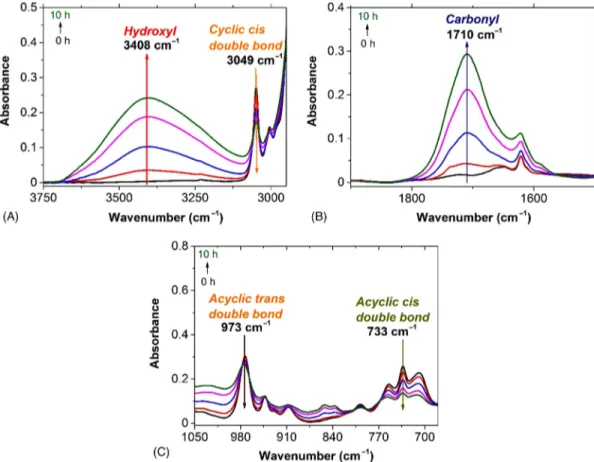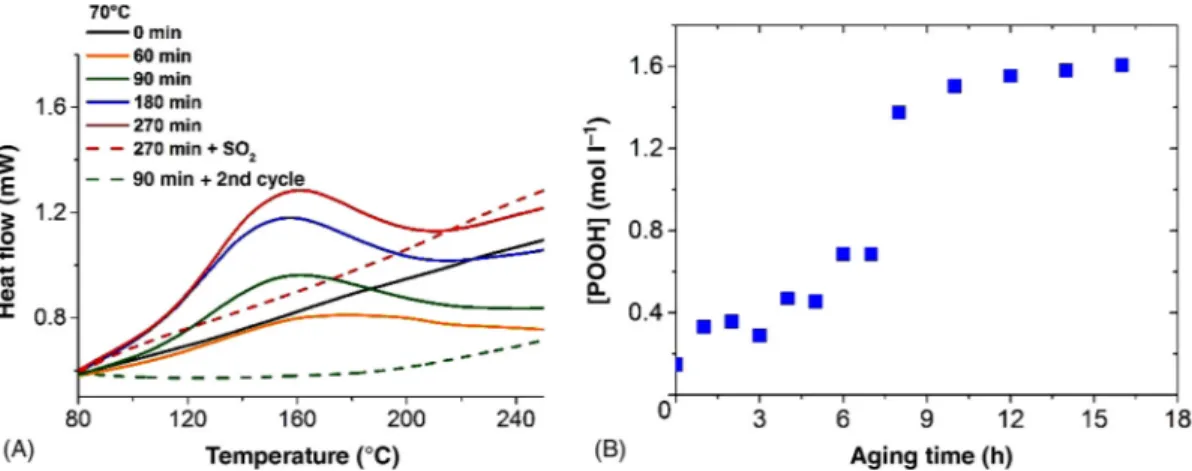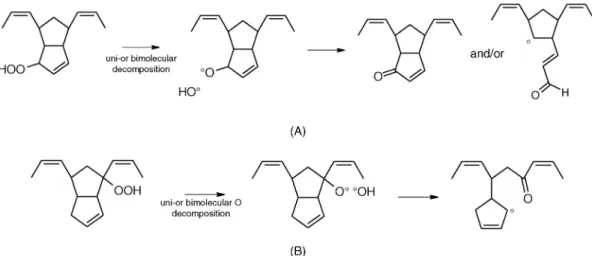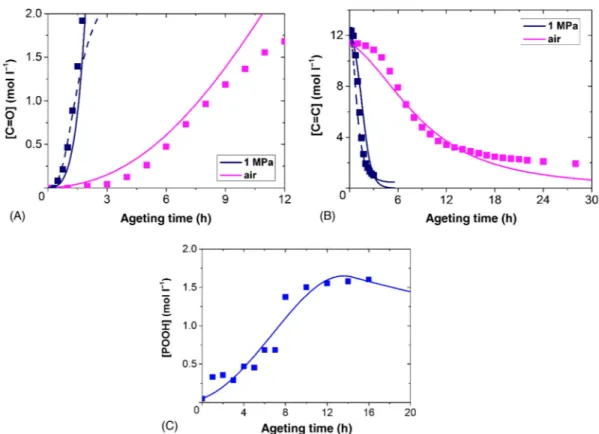Science Arts & Métiers (SAM)
is an open access repository that collects the work of Arts et Métiers Institute of Technology researchers and makes it freely available over the web where possible.
This is an author-deposited version published in: https://sam.ensam.eu Handle ID: .http://hdl.handle.net/10985/18617
To cite this version :
Jing HUANG, Emmanuel RICHAUD, Pierre-Yves LE GAC, Adelina DAVID, Renata DROZDZAK, Recher GILLES - Multiscale study and kinetic modeling of PDCPD thermal oxidation - 2020
Any correspondence concerning this service should be sent to the repository Administrator : archiveouverte@ensam.eu
Multiscale study and kinetic
modeling of PDCPD thermal
oxidation
Jing Huang
a, Emmanuel Richaud
a, Pierre-Yves Le Gac
b, Adelina David
b,
Renata Drozdzak
c, Gilles Recher
caLABORATOIRE PIMM, ENSAM, CNRS, CNAM, HESAM, 151 BOULEVARD DE L’HÔPITAL, PARIS, FRANCE; bIFREMER, SERVICE MATÉRIAUX ET STRUCTURES, CENTRE DE BREST BP70, PLOUZANÉ, FRANCE; cTELENE SAS, 2, RUE MARIE CURIE, BONDUES, FRANCE
1 Introduction
PDCPD is one of the youngest members of the thermoset family. It was developed in the laboratories of BFGoodrich and Hercules and is now used on large scale in a variety of applications. Compared to other thermosets, PDCPD has excellent impact performance, superior chemical resistance, and very low water absorption (0.09% weight increase after 24 h in water). PDCPD areas of applications include large to very large parts, typically in small to medium series, possibly used in hostile environments, and where design freedom is favored. Some examples include body panels for agricultural and construction equip-ment, trucks and buses where PDCPD brings high impact resistance even at −40°C, and a high heat deflection temperature (typically > 100°C). PDCPD is obtained through Ring Opening Metathesis Polymerisation (ROMP) of the DCPD monomer. ‘ROMP reaction’ is a metal carbene catalyzed reaction using strained cyclic olefins to produce a wide range of polymers. The driving force is the relief of ring strain.
Today’s commercial DCPD resin formulations based on Molybdenum and Tungsten are processed using Reaction Injection Moulding (RIM). In the RIM process two or three monomer streams are brought together in a mixing head and then injected in the mould where the polymerisation takes place. The RIM process is especially suitable to produce large plastic parts. The formulations based on Ruthenium catalysts are no longer limited to RIM but can be used in a variety of thermoset process such as resin infusion and RTM. The robust nature of the Ruthenium catalysts allows using reinforcements such as glass and mineral fibers, foaming agents, and other types of fillers. It has been demonstrated that PDCPD glass fibers composites exhibit superior fatigue resistance and damage toler-ance without compromising on the ultimate strength.
PDCPD has excellent impact performance, superior chemical resistance, very low water absorption, very low dielectric constant, excellent thermal stability, and intrinsic fracture-toughness properties that are desirable for a variety of applications. The high density of carbon-carbon double bonds in the polymer backbone makes polydicyclopentadiene sus-ceptible to oxidation. The oxidized layer which is formed spontaneously on PDCPD thick parts allows efficient part painting by using conventional paints.
The oxidation process, however, can also lead to the oxidative polymer damage which might have an important influence on overall mechanical properties. Polymer aging due to oxidation is considered as irreversible. Therefore, it is very important to understand the oxi-dation mechanism of PDCPD polymer and find a method to increase its oxidative stability.
2 Mechanical failure in PDCPD submitted to thermal
oxidation
When PDCPD undergoes oxidation, large changes of the mechanical behavior occur as shown in Fig. 7.1. This figure plots tensile curves of 3 mm thick PDCPD for several aging duration in oven at 140°C. A large decrease in elongation at break clearly appears whereas the modulus is almost constant during oxidation. This large decrease in fracture proper-ties is related to chemical modification of the network during the degradation. In fact, during polymer oxidation both chain scission and crosslinking occur. For PDCPD, a large crosslinking process occurs due to the presence of double bonds in the polymer backbone. This crosslinking process can be highlighted considering the modulus in the rubbery state that is directly proportional to the crosslink density in the material. For example, Fig. 7.2
shows DMA results for several aging durations in seawater at 90°C where degradation pro-cesses are similar as in air. A clear increase in the rubbery plateau is observed that clearly indicates a large increase in crosslink density during oxidation.
Previous results obtained with 2 mm thick samples revealed that the oxidation process is limited by oxygen diffusion and a degradation profile exists through sample [1] (as it
will be developed in the next section). In order to understand mechanical changes during oxidation process of the PDCPD, thin films (i.e., 60 µm thick samples) were aged at 80°C in oven. In these conditions, oxidation is homogeneous through sample thickness. Changes in Young’s modulus and maximal stress during oxidation are plotted in Fig. 7.3.
Both modulus and maximal stress increase during oxidation, which can be related to the crosslinking process induced by degradation. First, the modulus in glassy state is related to cohesion and segmental mobility [2] and its changes will be studied in future work. Then let us consider the maximal stress increase. During crosslinking induced by
FIGURE 7.2 Change in modulus with temperature for different aging times in seawater at 90°C [1].
FIGURE 7.3 Changes in Young modulus (A) and maximal stress (B) as function of aging time using 60 µm thick films aged at 80°C.
oxidation, an increase of Tg is expected. In fact, according to Eyring’s equation based on
free volume theory at a given strain rate it is possible to show that stress at yield is directly related to Tg according to:
T
C T
y g
σ = ⋅
(
−)
where σy is the stress at yield, C is a constant that depends on strain rate, Tg is the glass
temperature transition and T the absolute temperature.
As a conclusion it appears that oxidation leads to a large increase in crosslink density. In terms of mechanical behavior, it leads to a drastic reduction of the elongation at break, a slight increase in Young modulus related to cohesive energy as well as an improvement in maximal stress. This latter increase can be attributed to an increase in Tg that will be
characterized in the future.
3 Molecular changes in oxidized PDCPD
3.1 Estimation of thickness of oxidized layer
The effect of sample thickness has been studied by TGA. Samples with different thicknesses were aged at 120 and 150°C under 1 bar O2 so as to determine the maximal thickness below
which oxidation is not controlled by oxygen diffusion. TGA curves are presented in Fig. 7.4. At 150°C, the rate of mass uptake reaches rapidly its maximal value (rm). The maximal rate
seems almost constant for samples having a thickness lower than about 20 µm (Fig. 7.4) which corresponds to twice the thickness of oxidized layer (TOL). Since it is well estab-lished that the TOL decreases with temperature [3,4], its value will, hence, be assumed higher than 10 µm for temperatures lower than 150°C so that oxidation will be studied for samples about 10 µm thick.
σy=CTg−T
3.2 Detection and quantification of hydroperoxides
Infrared spectra shows a growth of a hydrogen bonded hydroxyl band at ca. 3400 cm–1
(Fig. 7.5A). This broad band consists of various species corresponding to hydroxyl groups being either hydroperoxides, alcohols or carboxylic acids, all of which being reported to be oxidation products in other hydrocarbon polymers [6]. It is, however, difficult to really distinguish all these species.
However, hydroperoxides (being the key species of the oxidation mechanisms) can also be detected and quantified by other chemical or thermal methods [7]. The following DSC procedure was used for the titration of hydroperoxides:
• equilibrate at room temperature
• heating to 300°C under nitrogen at a 10°C min–1 rate
The DSC traces of oxidized samples reveal the growth of an exotherm centered at about 150°C which disappears upon treatment by sulfur dioxide (Fig. 7.6A). The same disap-pearance occurs after the second cycle of the same DSC procedure. That means that this
FIGURE 7.5 Changes of FTIR spectra of purified PDCPD exposed at 50°C under air in hydroxyl (A), carbonyl (B), and
titration of hydroperoxides is irreversible. This exotherm is hence attributed to the decom-position of hydroperoxides (POOH) formed during the propagation step (Scheme 7.1).
PDCPD exposed at 70°C under air (1). Changes in hydroperoxides for PDCPD exposed at 50°C under air (2).
Several kinds of hydroperoxides can be formed (Fig. 7.7).
POOH concentration was calculated (Fig. 7.6B) using a molar enthalpy (440 kJ mol–1)
given by our previous study [8]. At 50°C, it is observed to increase rapidly in the earliest exposure time to reach a value of about 1.5 mol l–1 after 10 h of exposure and then to reach
a plateau. Hydroperoxides are an intermediate species of oxidation process and decom-pose later to generate stable products as presented below.
3.3 Carbonyl build-up
Fig. 7.5B displays a complex carbonyl band in the 1650–1750 cm–1 region with a maximum
centered at ca. 1710 cm–1 corresponding to the aldehydes or ketones. There are at least
three kinds of reactions likely to explain their origin:
① By initiation process (i.e., uni- or bimolecular decomposition of peroxides), for example as shown in Scheme 7.2.
NB : hydroperoxides decomposition by uni- or bimolecular process generate the same kind of alkoxy radical :
FIGURE 7.6 DSC thermograms before (full line) and after (dashed line) SO2 treatment for purified.
SCHEME 7.1 Propagation step in PDCPD.
POOH → PO° + °OH
POOH + POOH → POO° + PO° + H2O
And then: PO° → γ1P=O + (1 − γ1)POH, P=O being a carbonyl and POH and alcohol.
② By the decomposition of dialkylperoxides generated by the termination process between an alkyl (P°) and a peroxyl (POO°) (Scheme 7.3A):
③ By the decomposition of tetroxides generated by termination process between two peroxy (POO°) radicals (Scheme 7.3B) [9].
It must be mentioned that POOP and POOOOP decomposition generate a pair of alk-oxy radicals in each case, so that the mechanisms can be considered as close. However, the kinetics are not priori because POOP and POOOOP stabilities are not the same.
Their concentration was calculated using the Beer-Lambert law with a molar absorptiv-ity of 300 mol l–1 cm–1[10]. The changes in concentration are depicted in Fig. 7.8B showing
an increase of carbonyl concentration over time with the classic self-accelerating shape characteristic for the oxidation of hydrocarbon polymers.
3.4 Double bond consumption
On the basis of Infrared results (Fig. 7.5A and C), it is possible to distinguish three types of double bonds in the structure of PDCPD: cyclic double bond at 3049 cm–1, acyclic
cis double bond at 733 cm–1 and acyclic trans double bond at 973 cm–1, which decrease
with aging time. Similarly, double bonds concentration was calculated with using the Beer-Lambert equation with molar absorptivity of 19 mol l–1 cm–1 (calculated with the
help of cyclopentene) at 3049 cm–1, 60 mol l–1 cm–1[11] at 733 cm–1, and 100 mol l–1 cm–1
[12] at 973 cm–1.
Fig. 7.8A shows that the changes of normalized concentration of different types of dou-ble bonds, the consumption rate divided by the initial concentration of these three types
of double bonds are almost the same. The first hypothesis in kinetic simulation is hence that these three types of double bonds are very close (i.e., one rate constant is valid for each sort of double bonds).
According to Fig. 7.8B, the double bonds concentration decreases with aging time, cer-tainly because of opening by alkyl of peroxyl radicals (Scheme 7.4):
4 Kinetic modeling
According to the above reported changes, it seems that the following mechanistic scheme might be used for modeling the kinetic curves for PDCPD:
(1u) POOH → 2P° + γ1P=O k1u
(1b) POOH + POOH → P° + POO° + γ1P=O k1b
(2) P° + O2 → POO° k2
(3) POO° + PH → POOH + P° k3
(A-1) P° + F → x + P° ka1
(A-2) POO° + F → γ1P=O + P° ka2
(4) P° + P° → γ4x + (1 − γ4)F k4
(5) P° + POO° → γ5POOP + γ5x + (1 − γ5)F + (1 − γ5)POOH k5
(6) POO° + POO° → P=O + POH k6
where POOH, P°, POO°, PH, F, P=O are, respectively, hydroperoxides, alkyl, peroxy radicals, abstractable C−H, double bonds and carbonyls, x is crosslinking, ki, and γi are,
respec-tively, kinetic rate constants and yield for each reaction.
As published elsewhere [13] the mechanistic scheme leads to a set of differential equa-tions. The numerical solution of this later leads to a simulation of experimental results using the following equations:
γ γ
(
)
(
)
[ ]
= −[ ][ ]
° −[
°][ ]
+ −[ ]
° + −[ ][
° °]
d F dt ka1 P F ka2 POO F 1 4 P 1 s k P POO 2 5 d P Odt 1 1ku POOH 1 1kb POOH ka POO C C k POO
2
1 2 6 2
γ γ γ
[
=]
=[
]
+[
]
+[
°][
=]
+[
°]
d POOH
dt k1u POOH 2k1b POOH k POO PH k 1 P POO
2
3 5
(
γ5)
[
]
= −[
]
−[
]
+[
°][ ]
+ −[ ][
° °]
dFdt=−ka1PˆF−ka2POOˆF+1−γ4Pˆ2+1−γsk5PˆPOOˆ
dP=Odt=γ1k1uPOOH+γ1k1bPOOH2 +γ1ka2POO°C=C+k6POO°2
dPOOHdt=−k1uPOOH−2k1bPOO H2+k
3POO°PH+k51−γ5P°POO° FIGURE 7.8 Concentration changes in acyclic trans double bonds at 3050 cm–1 (■), acyclic cis double bonds at 973 cm–1
(), cyclic cis double bonds at 733 cm–1 (▲ ) for exposure at 50°C under air (A) and in carbonyl (■) and double bonds ()
for exposure at 50°C under air (B).
The main aim is to estimate each rate constant from accelerated aging tests is to use their extrapolation to any other given exposure conditions to perform a prediction of changes in chemical structure and later the change in crosslinking from:
dx dt 4 4k P ka P F k P POO 2 1 5 5 γ
[ ]
[ ][ ]
γ[ ][
]
= ° + ° + ° °It is thus needed to propose a reliable method for estimating each involved kinetic parameter. There are schematically two options:
• Estimate the set of rate constant from best fitting approach. However, there is infinity of possible sets given the high number of parameters compared to the relative simplicity of kinetic curves for oxidation in the earliest exposure time.
• Assess independently rate constants from specific experiments, as it will be developed below.
According to several papers, the rate constants for propagation obey well-defined structure-oxidizability relationships:
• k2 is close to 108 l mol–1 s–1 for hydrocarbon compounds [14]
• k3 is taken from the value of polybutadiene which is unsaturated thermoset like
PDCPD [13]
It remains to estimate k1u, k1b, ka1, ka2, k4, k5, and k6.
The thermolysis under vacuum of hydroperoxides previously generated during an exposure under air is described by the following equation:
d POOH
dt k1u POOH 2k1b POOH
2
[
]
= −[
]
−[
]
However, when POOH concentration reaches the plateau in Fig. 7.6B, thermolysis data fit pretty well with a second order reaction kinetics, consistently with the relatively high concentration in POOH making the bimolecular decomposition much faster than first order one. The rate constant for bimolecular process k1b can thus be directly estimated
from the slope in in Fig. 7.9.
The unimolecular process is, however, expected to play a more significant importance at low hydroperoxides concentration, i.e., in the earliest conversion degrees. Its impor-tance is also supposed to be greater under air than under elevated oxygen pressure (since POOH concentration increases with external oxygen pressure) [15].
We have thus chosen the following strategy:
• The value of k1b is the slope of this bimolecular linear equation. The yield of carbonyl
γ1 was obtained by thermolysis of hydroperoxides (Fig. 7.10).
• k1u is adjusted from the kinetic curves to permit a good fit under air and elevated
oxygen pressure.
Let us now turn to rate constants for termination (k4, k5, k6) and double bonds
open-ing (ka1, ka2). Under very elevated oxygen pressure, P° radicals are almost instantaneously
dxdt=γ4k4P°2+ka1P°F+γ5k5P°POO°
scavenged so that reactions (a1), (4) and (5) are almost negligible. It can thus be shown in a first approach that:
v d P O dt k POOH k POO k PH k 1 4 ox excess 1b 1b 2 6 6 2 1b 3 2 6 γ γ
(
γ)
[
]
[
]
[
]
[ ]
= = = + ° = + v d C C dt k POO F k k F k C C excess a2 a2 3 2 6[
]
[
][ ]
[ ]
= − = = ° = =With these approximate calculations, ka2 and k6 were thus determined at 50°C. Using
k2 and k3 from literature, and k1b from thermolysis experiments, a first simulation run was
obtained (dotted line in Fig. 7.11). Then the above complete mechanistic scheme (with k6,
k01, and k02) was used for adjusting k4, k5, ka1, and k1u to fit the available experimental data
under oxygen excess and under air (full line in Fig. 7.11). All the oxidation rate constants utilized for simulation runs are summarized in Table 7.1.
vox excess=dP=Odt=γ1bk1bPOOH2 +γ6k6POO°2=γ1b+1k32PH4k6
vC=C excess=−dC=Cdt=ka2POO°F
=ka2k3F2k6 FIGURE 7.9 Thermolysis curve of hydroperoxides at 90°C in N2 (A). Second order plot for POOH decomposition (B).
The model failure to simulate the degradation at longer exposure time suggests fur-ther improvements (taking in to account of ofur-ther reactive sites than allylic sites) would be needed. However, our main aim was to simulate the gradation until embrittlement which occurs at relatively lower conversion degrees.
FIGURE 7.11 Simulation runs for carbonyl (P=O) (A) and double bonds (C=C) (B) and POOH (C) at 50°C under 1 MPa and
under air.
Table 7.1 Rate constants at 50°C for PDCPD, k1u in s–1, k1b, k2, k3, ka1, ka2, k4, k5, k6 in
1 mol–1 s–1.
Run for dotted line
k1u k1b k2 k3 ka1 ka2
1.2 × 10–5 1.8 × 10–6 1.0 × 108 0.048 0 0.37
k4 k5 k6 γ1 γ4 γ5
0 0 10 0.25 0 0
Run for full line
k1u k1b k2 k3 ka1 ka2
1.2 × 10–5 1.8 × 10–6 1.0 × 108 0.048 9000 0.37
k4 k5 k6 γ1 γ4 γ5
It is shown that the set of kinetic constants obtained by inverse method makes it pos-sible to obtain a satisfying simulation of the accumulation curves of carbonyls, hydroper-oxides and decrease curves of double bonds. Moreover, the magnitude orders of these rate constants follow the following classification:[16]
109 k k k
4 5 6
> ≥ > which is general classification for most polymers.
The order of magnitude of ka1 with ka2 for PDCPD is observed to be in line with the case
of the other rubbery polymers (see Table 7.2) where: k ka1 a2
5 Conclusions
This chapter presents a methodological approach for predicting the lifetime of polymers applied in the case of PDCPD submitted to thermal oxidation. It is shown this polymer undergoes thermal oxidation leading mainly to an increase in Tg and yield stress and a
decrease of ultimate elongation. The rate of crosslinking can be predicted from a non-empirical model in which kinetic approach describes the chemical changes induced by thermal oxidation (mainly the appearance of oxygenated species such as unstable perox-ides and stable carbonyls). The proposed model can reasonably fit the experimental data presented here for aging at 50°C. It remains now to extend those predictions in the case of bulky materials (i.e., by adding the diffusion coupling phenomena) together with add-ing to the mechanistic scheme the effect of commercial antioxidants to dispose of a non-empirical tool for polymers lifetime prediction.
References
[1] P.Y. Le Gac, D. Choqueuse, M. Paris, G. Recher, C. Zimmer, D. Melot, Durability of
polydicyclopentadiene under high temperature, high pressure and seawater (offshore oil production conditions), Polym. Degrad. Stab. 98 (2013) 809–817, doi: 10.1016/j.polymdegradstab.2012.12.023. [2] J.-P. Pascault, H. Sautereau, J. Verdu, R.J. Williams, Thermosetting polymers, Marcel Dekker, New
York, (2002).
[3] P. Gijsman, W. Dong, A. Quintana, M. Celina, Influence of temperature and stabilization on oxygen diffusion limited oxidation profiles of polyamide 6, Polym. Degrad. Stab. 130 (2016) 83–96, doi: 10.1016/j.polymdegradstab.2016.05.024.
[4] M. Celina, J. Wise, D.K. Ottesen, K.T. Gillen, R.L. Clough, Oxidation profiles of thermally aged nitrile rubber, Polym. Degrad. Stab. 60 (1998) 493–504, doi: 10.1016/S0141-3910(97)00113-4.
109>k 4≥k5>k6
ka1>> ka2 Table 7.2 Constant rates used for modeling oxidation at 50°C.
Polybutadiene [13] Polyisoprene [17] Polychloroprene [18]
ka1 (l mol–1 s–1) 620 3.83 × 104 97
[5] V. Defauchy, P.Y. Le Gac, A. Guinault, J. Verdu, G. Recher, R. Drozdzak, E. Richaud, Kinetic analysis of polydicyclopentadiene oxidation, Polym. Degrad. Stab. 142 (2017) 169–177, doi: 10.1016/j. polymdegradstab.2017.06.005.
[6] E. Richaud, F. Farcas, B. Fayolle, L. Audouin, J. Verdu, Hydroperoxide build-up in the thermal oxidation of polypropylene – a kinetic study, Polym. Degrad. Stab. 92 (2007) 118–124, doi: 10.1016/j. polymdegradstab.2006.08.010.
[7] J.-L. Gardette, J. Lemaire, Advantages and limits of hydroperoxide titration methods in solid polymers, Polym. Photochem. 7 (1986) 409–416, doi: 10.1016/0144-2880(86)90008-4.
[8] E. Richaud, P.Y. Le Gac, J. Verdu, Thermooxidative aging of polydicyclopentadiene in glassy state, Polym. Degrad. Stab. 102 (2014) 95–104, doi: 10.1016/j.polymdegradstab.2014.01.036.
[9] G.A. Russell, The rates of oxidation of aralkyl hydrocarbons. Polar effects in free radical reactions 1, 2, J. Am. Chem. Soc. 78 (1956) 1047–1054, doi: 10.1021/ja01586a047.
[10] E. Richaud, F. Farcas, B. Fayolle, L. Audouin, J. Verdu, Hydroperoxide titration by DSC in thermally oxidized polypropylene, Polym. Test. 25 (2006) 829–838, doi: 10.1016/j.polymertesting.2006.04.010. [11] J. Calvert, J. Pitts, Photochemistry, Wiley, New York, (1966).
[12] H.L. McMurry, V. Thornton, Correlation of infrared spectra, Anal. Chem. 24 (1952) 318–334, doi: 10.1021/ac60062a018.
[13] M. Coquillat, J. Verdu, X. Colin, L. Audouin, R. Nevière, Thermal oxidation of polybutadiene. Part 2: Mechanistic and kinetic schemes for additive-free non-crosslinked polybutadiene, Polym. Degrad. Stab. 92 (2007) 1334–1342, doi: 10.1016/j.polymdegradstab.2007.03.019.
[14] E.T. Denisov, I.B. Afanas’ev, Oxidation and Antioxidants in Organic Chemistry and Biology, Taylor & Francis, Boca Raton, (2005).
[15] E. Richaud, F. Farcas, P. Bartoloméo, B. Fayolle, L. Audouin, J. Verdu, Effect of oxygen pressure on the oxidation kinetics of unstabilised polypropylene, Polym. Degrad. Stab. 91 (2006) 398–405, doi: 10.1016/j.polymdegradstab.2005.04.043.
[16] K.T. Gillen, J. Wise, R.L. Clough, General solution for the basic autoxidation scheme, Polym. Degrad. Stab. 47 (1995) 149–161, doi: 10.1016/0141-3910(94)00105-H.
[17] X. Colin, L. Audouin, J. Verdu, Kinetic modelling of the thermal oxidation of polyisoprene
elastomers. Part 1: Unvulcanized unstabilized polyisoprene, Polym. Degrad. Stab. 92 (2007) 886–897, doi: 10.1016/j.polymdegradstab.2007.01.017.
[18] P.Y. Le Gac, G. Roux, J. Verdu, P. Davies, B. Fayolle, Oxidation of unvulcanized, unstabilized polychloroprene: a kinetic study, Polym. Degrad. Stab. 109 (2014) 175–183, doi: 10.1016/j. polymdegradstab.2014.06.019.

![FIGURE 7.2 Change in modulus with temperature for different aging times in seawater at 90°C [1].](https://thumb-eu.123doks.com/thumbv2/123doknet/7406005.217831/4.810.190.642.98.436/figure-change-modulus-temperature-different-aging-times-seawater.webp)
![FIGURE 7.4 Gravimetric curves for purified PDCPD films and aged at 150°C under 1 bar O 2 [5].](https://thumb-eu.123doks.com/thumbv2/123doknet/7406005.217831/5.810.183.602.648.892/figure-gravimetric-curves-purified-pdcpd-films-and-aged.webp)




